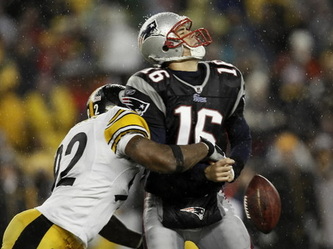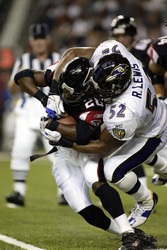Tackling
Tackling is arguably the most important aspect of playing on defense in a football game. If done correctly, it ends the current play and stops the offense from scoring. Tackling requires strength, awareness, and speed. Tackles happen nearly every single play of a football game, this is when a defensive player attempts to bring the offensive player to the ground to end a play. Patrick Willis (pictured above) is among the best tacklers in the game today, this last season he set a record for not allowing a single rushing touchdown until the last game of the season.
http://www.thefreedictionary.com/tackle
http://www.thefreedictionary.com/tackle
The Physics Behind Tackling
When a running back is in the open field, he has a momentum of roughly 960 kg-m/s. To stop or tackle him, a tackler must apply an equal impulse in the opposite direction. Since impulse is a product like momentum, the same impulse can be applied if one varies either the force of the impact or the time of contact. If a defender wants to tackle our running back, he would have to apply an equal impulse of 960 kg-m/s. If the tackle happens in about .5 seconds, then the force applied would be:
F = impulse/t = (960 kg-m/s)/(.5s) = 1921 N = 423 lbs
Also, if the defender increased the time he was in contact with the running back, he would be able to use less force to tackle him. In any tackle, where there is no force except for that of the collision, the total momentum of those involved stays the exact same before and after the impact. This is what we call the Conservation of Momentum.
http://www.howstuffworks.com/physics-of-football4.htm
F = impulse/t = (960 kg-m/s)/(.5s) = 1921 N = 423 lbs
Also, if the defender increased the time he was in contact with the running back, he would be able to use less force to tackle him. In any tackle, where there is no force except for that of the collision, the total momentum of those involved stays the exact same before and after the impact. This is what we call the Conservation of Momentum.
http://www.howstuffworks.com/physics-of-football4.htm




